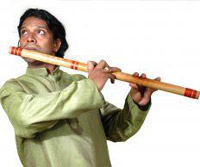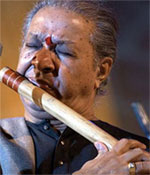BANSURI
History
The wind instrument Bansuri cahas been in vogue since the times of the Rig Veda, and is even found in the murals of Ajanta and Ellora caves. Bansuri is basically a folk instrument, invariably linked to the lives and playfulnesses of Krishna. However, it was during the Bhakti movement that the Bansuri raised to prominence. During the latter part of the 19th century, the Karnatic musical geniuses took up the Bansuri as an inseparable part of a concert ensemble.Slowly, it also was infused into the North Indian musical arena, basically by the untiring efforts of Pt. Pannalal Gosh. Untilthe 20th century the Indian musical instrument Bansuri was regarded as a purely folkloristic instrument. In Indian art and culture Bansuri is inextricably interlinked with the life and loves of Krishna. Musicologists convey that, along with the veena and the mridang, bansuri is one of the oldest Indian instruments.

Brief introduction
The majority of Bansuris in India are made of an untreated piece of bamboo cane around which strings are tightly wrapped in several places. It is basically to prevent the bamboo cane from cracking. The Indian Bansuri has a mouthpiece that is played in a similar way as the western transverse flute with either 6 or 7 finger-holes. The holes of bansuri have to be precisely covered either fully or half by the phalanxes of the fingers and not by the fingertips. Such technique simplifies the playing of longer Bansuris. Due to the fluent movements of the fingers the typical sliding transitions between notes, typical Indian music is achieved. The basic note usually describes the Indian note "Sa" which is obtained by closing the first three finger-holes and then blowing the Bansuri.Parts of the Bansuri
Dandi - The dandi is the body of the bansuri.Mukha Randhra - This is the embouchure, or the blowing hole. Professional quality bansuris in India are invariably of the transverse variety.
Swar Randhra - These are the finger holes. They are the holes that are used to play the melodies.
Garbha Randhra - This is the opening of the bansuri. It should remain unoccluded at all times
Rassi - The body of the bansuri tends to crack. The cracking is reduced or eliminated by tightly binding the body with twine.
How to play a Bansuri
Getting sound is the most crucial aspect of playing the bansuri which is the one that makes 99% of potential bansuri players quit on day one. It might take several days before a new player can get a consistent sound, but once a player learns to play, then it is forever so it is very important to concentrate for the first few days. To hear the sound, touch the mouth hole to the point half-way down your lower lip, and blow air basically across the top of the hole, like half of the air should be going into the hole and half over it. Should not cover more than the first couple holes, for if any hole is not entirely closed you will not hear sound. Covering only one or two holes at first or none at all is always recommended by experts. For balancing the flute when no holes are closed, use both thumbs and your right pinky. Your mouth serves as the 4th point of balance.Popular Musicians

Some of the top ranking professionals who play Bansuri in their concerts include maestros like Pt. Hariparsad Chaurasia, Pt.Ronu Majumdar, Pt. Amarnath, Pravin Godkhindi, Kailash Sharma, K S Rajesh, Keshav L. Ginde, Deepak Ram, Mujtaba hussain, David philipson, Butto, G. S. Rajan, Kudamaloor Janardanan, Flute Raman, Ravichandra Kullur, Naveen who is popularly known for his works with A. R. Rahman & one of the leading Flutists in Indian Film industry.
Where to Learn to play the Bansuri
There are many insititutions which teach bansuri like Bansuri Foundation, Hariparsah Chaurasiyas Bansuri Guru and other Bansuri Schools which help individuals to develop skills to learn and play BansuriTARANG School for Classical Indian Dance and Music
Manager: Marie-Luise Siebenkaes
Johannisstrasse 14D-90763 Fuerth
Germany Telephone: +49-(0)911-6708040
Fax: +49 (0)1212-512616701 USt-IdNr.: DE228189973
Where to buy a Bansuri
Contact: Mr Ashish ShrivastavaSathyadeep Musical Palace
Beside Vysya Bank
Post- Puttaparthy
Dist-- Anantapur
Andhra Pradesh Pin- 515134
INDIA
[email protected]
[email protected]


